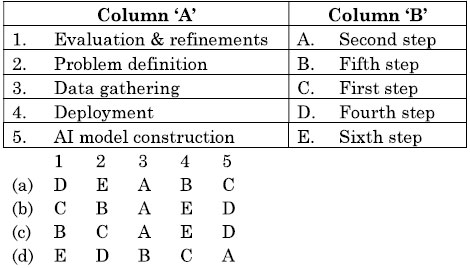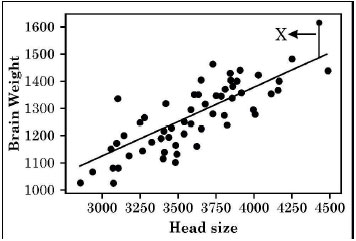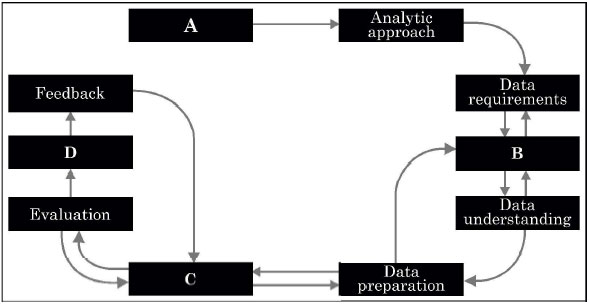Series ƩHEFG
Question Paper Code 367 Set 4
ARTIFICIAL INTELLIGENCE – SOLUTION
(Session 2022-23)
Time allowed : 2 hours
Maximum Marks : 50
General Instructions :
- Please read the instructions carefully.
- This Question Paper consists of 21 questions in two sections: Section A & Section B.
- Section A has Objective type questions whereas Section B contains Subjective type questions.
- Out of the given (5 + 16 =) 21 questions, a candidate has to answer (5 + 10 =) 15 questions in the allotted (maximum) time of 2 hours.
- All questions of a particular section must be attempted in the correct order.
- SECTION A – OBJECTIVE TYPE QUESTIONS (24 MARKS):
- i. This section has 05 questions.
- ii. Marks allotted are mentioned against each question/part.
- iii. There is no negative marking.
- iv. Do as per the instructions given.
- SECTION B – SUBJECTIVE TYPE QUESTIONS (26 MARKS):
- i. This section has 16 questions.
- ii. A candidate has to do 10 questions.
- iii. Do as per the instructions given.
- iv. Marks allotted are mentioned against each question/part.
Section – A (Objective Type Questions)
1. Answer any 4 out of the given 6 questions on Employability Skills. 4×1=4
(I) Narcissistic personality disorder is characterized by which of the following condition(s)
i. People have an inflated sense of their own importance.
ii. A deep need for excessive attention.
iii. Admiration and lack of empathy.
iv. Introvert
a) Only i
b) Both i and ii
c) i, ii and iii
d) i, ii, iii and iv
(II) “S” in acronym SMART in Goal setting stands for :
a) Strong
b) Segment
c) Specific
d) Special
(III) ____ an economic process, where an idea is generated or an opportunity is created, refined, developed and implemented, while being exposed to uncertainty, to realise a profit by effective utilisation of resources.
a) Entrepreneurs
b) Entrepreneurship development
c) Entrepreneurship
d) Cluster intervention
(IV) In a spreadsheet software, an arrangement of cells in a vertical manner is known as:
a) Worksheets
b) Workbooks
c) Rows
d) Columns
(V) Which of the following is not an example of a spreadsheet ?
a) Microsoft Excel
b) LibreOffice Calc
c) OpenOffice Impress
d) Google Sheets
(VI) Which entrepreneur, out of the following, is essentially a manufacturer, who identifies the needs of customers and creates products or services to serve them ?
a) Service entrepreneur
b) Industrial entrepreneur
c) Agricultural entrepreneur
d) Technical entrepreneur
2. Answer any 5 out of the given 6 questions. 5×1=5
(I) A training set is a set of ____ data in which the outcomes are already known.
a) current
b) instant
c) historical
d) output
(II) ____ involves a combination of three key elements, that help to explain the audience whats happening in the data in an engaging and entertaining manner.
a) Data Analysis
b) Data Visualization
c) Data Storytelling
d) Data Narrative
(III) Match the following step of Al project given in column ‘A’ with its exact sequence given in column ‘B’.
c) B C A E D
(IV) In AI development which of the following framework is used ?
a) Python
b) TensorFlow (Answer)
c) Visual Basic
d) C++
(V) All the algorithms in machine learning rely on minimizing or maximizing a function, called as
a) Objective function
b) Focal Loss
c) Loss function
d) Gradient Descent
(VI) Which of the following is incorrect ?
a) The testing phase is essentially an iterative process.
b) The first fundamental step when starting an AI initiative is scoping.
c) In scoping phase, it’s crucial to precisely define the strategic business objectives and desired outcomes of the project,
d) Test data should include all relevant subsets of training data.
3. Answer any 5 out of the given 6 questions. 5 x 1=5
(I) When visuals are applied to data, they can ____ the audience to the insights that they wouldn’t perceive without the charts or graphs.
a) engage
b) explain
c) enlighten
d) change
(II) It is believed that if there is a ____ in the data, then AI development techniques may be employed.
a) pattern
b) program
c) language
d) logic
(III) Assertion (A) : It’s crucial to precisely define the strategic business objectives and desired outcomes of the project, align all the different stakeholders’ expectations, anticipate the key resources and steps, and define the success metrics.
Reason (R) : Selecting the AI or machine learning use cases and being able to evaluate the Return on Investment (ROI) is critical to the success of any data project.
Select the appropriate option for the statements given above :
a) Both (A) and (R) are true and (R) is the correct explanation of(A).
b) Both (A) and (R) are true and (R) is not the correct explanation of (A).
c) (A) is true, but (R) is false.
d) (A) is false, but (R) is true.
(IV) Which of the following shows the audience where to look and what not to miss and also keeps the audience engaged ?
a) data
b) narrative
c) charts
d) story
(V) Once the relevant projects have been selected and properly scoped, which of the following phase will be the next step of the machine learning lifecycle?
a) Problem Scoping
b) Deployment
c) Design
d) Testing
(VI) Which of the following is the first stage of an AI Model Life Cycle ?
a) Build
b) Scoping
c) Design
d) Testing
4. Answer any 5 out of the given 6 questions. 5×1=5
(I) Which of the following is the most preferred language for building an AI model ?
a) Python
b) VB
c) Java
d) C++
(II) Study the following graph :
What does the line in the above figure represent ?
a) Actual values
b) Set of predicted values
c) It represents the error
d) Values at Y aixs
(III) First four steps of writing Python code to find out RMSE values of the model are given here. Arrange them in proper order –
1. Splitting the data into training and test.
2. Reading the data.
3. Fitting simple linear regression to the training set.
4. Import required libraries
a) 2-4-1-3
b) 4-3-2-1
c) 1-2-3-4
d) 4-2-1-3
IV) Which of the following is NOT True for Testing ?
a) The volume of test data should be very small.
b) Data validation is important.
c) Your testing team should test the AI and ML algorithms keeping model validation.
d) Your team must create test suites that help you validate your ML models.
(V) Data storytelling is a ____ approach for communicating insights drawn from data.
a) iterative
b) procedural
c) sequential
d) structured
(VI) Which of the following is NOT true for Train-Test Split Evaluation ?
a) The procedure involves taking a dataset and dividing it into two subsets.
b) The train-test procedure is appropriate when there is a larger dataset.
c) The objective is to estimate the performance of the user.
d) Itcan be used for classification or regression problems.
5. Answer any 5 out of the given 6 questions. 5×1=5
(I) Stories create ____ experiences that transport the audience to another space and time.
a) visualizations
b) engaging
c) testing
d) necessary
(II) Which of the following is incorrect ?
i. A capstone project is a project where students must research a topic independently to find a deep understanding of the subject matter.
ii. The initial part of the project of academic program is known as capstone project.
iii. The final project of an academic program, integrating all of the learning from the program is called capstone project.
a) i and iii only
b) ii and iii only
c) ii only
d) i, ii and iii
(III) Which of the following is an example of a development tool used in building an AI model ?
a) C++
b) Anaconda
c) Linux
d) Scratch
(IV) Identify the correct statements from the following :
i. Data modeling focuses on developing modes that are either descriptive or predictive.
ii. A predictive model tries to yield yes/no, or stop/go type outcomes.
iii. The data scientist will use a training set for descriptive modelling.
iv. Data modelling focuses on testing the project.
a) i, ii, and iii
b) ii, iii and iv
c) i and ii
d) i and iv
(V) ____ is a design methodology that provides a solution-based approach to solving problems.
a) Classification
b) Design Thinking
c) Recommendation
d) Computational
(VI) Which of the following is a key element of a data story ?
a) audience
b) visuals
c) engage
d) information
Section – B (Subjective Type Questions)
Answer any 3 out of the given 5 questions on Employability Skills. 3×2=6
Answer each question in 20-30 words :
6. With reference to ‘Five Factor Model’, mention any four parameters that describe an individual’s personality.
Answer: The Five Factor Model (also known as the Big Five personality traits) describes an individual’s personality based on five broad dimensions. Here are four parameters, or dimensions, from the Five Factor Model:
1. Openness to Experience
2. Conscientiousness
3. Extraversion
4. Agreeableness
5. Neuroticism
7. Define any two of the following personality disorders :
(a) Avoidant
(b) Dependent
(c) Histrionic
Answer: (a) Avoidant Personality Disorder (AVPD):
This is when someone is really, really shy and scared of being judged or rejected by others. They often avoid social situations because they’re afraid of looking foolish or being embarrassed.
(b) Dependent Personality Disorder (DPD):
This is when a person relies too much on others to make decisions and take care of them. They have a hard time doing things on their own and need constant support from others.
(c) Histrionic Personality Disorder (HPD):
This is when someone always wants to be the center of attention and acts very dramatic to get noticed. They might seem like they’re overacting to get people to like them.
8. Differentiate between a row and a cell of a spreadsheet.
Answer: A row is a horizontal line of cells that goes from left to right, and a cell is a single rectangular box within a row and column where you can enter data like numbers, text, or formulas.
9. Write any four qualities that motivate an entrepreneur.
Answer: Certainly, here are four qualities that can motivate an entrepreneur in simple terms:
1. Passion: Passion means having a strong love and excitement for what you’re doing. Entrepreneurs are often motivated by their passion for their business idea or the problem they want to solve.
2. Creativity: Creativity is the ability to come up with new and innovative ideas. Entrepreneurs are motivated by the opportunity to create something unique and valuable.
3. Independence: Independence means being your own boss and making your own decisions. Entrepreneurs are motivated by the desire for freedom and control over their work.
4. Opportunity: Opportunity is the chance to make money or achieve success. Entrepreneurs are motivated by the potential for financial gain and the opportunity to make a difference in their industry or community.
10. Briefly define the term competency. Mention any two Common Entrepreneurial Competencies.
Answer: Competency is like being good at something. It’s a skill or ability you have. Two common skills that entrepreneurs often have are:
1. Being Creative: This means thinking up new and different ideas, which can be really useful in starting a business.
2. Managing Risk: This means being able to understand and handle situations where things might go wrong or be uncertain, like in business.
Answer any 4 out of the given 6 questions in 20-30 words each. 4×2=8
11. Mention the names of any four stages of Design Thinking.
Answer: Design Thinking typically consists of five stages. Here are the names of the four stages: (5th stage is “Test”)
1. Empathize
2. Define
3. Ideate
4. Prototype
12. Explain the term Time series decomposition.
Answer: Time series decomposition is like taking apart a puzzle to understand its pieces. When we have data collected over time, like daily sales figures or monthly temperature readings, time series decomposition helps us break this data into different parts.
13. Give two points of difference between Cross-Validation and Train-Test Split.
14. Selecting the right analytical approach depends on the questions being asked.
Answer: In the light of the above given statement, which type of questions can be asked for (A) Classification approach (B) Descriptive approach
15. Name the main stages of AI project Life cycle.
Answer: The main stages of an AI (Artificial Intelligence) project lifecycle typically include the Problem Scoping, Data Acquisition, Data Exploration, Modelling, Evaluation
16. Give two reasons why storytelling is so powerful ?
Answer any 3 out of the given 5 questions in 50-80 words each. 3×4=12
17. Give steps to break down a problem into smaller units before coding.
18. The following is the diagram depicting the Foundational methodology for data science.
The diagram is marked with A, B, C, D. Identify these four steps and briefly explain the significance of steps marked as ‘A’ and ‘B’.
Answer: Four steps are as following:
A: Business Understanding
B: Data Collection
C: Modelling
D: Deployment
Business Understanding refers to the first phase of a data science or analytics project, where the data scientist or analyst works closely with the business stakeholders to gain a deep understanding of the specific business problem or opportunity that needs to be addressed.
Data Collection, on the other hand, is a fundamental step in the data analysis process. It involves gathering the necessary data from various sources to perform the analysis and address the business problem.
19. Explain AI project cycle and project scoping in detail.
20. (a) Mention the steps that can assist in finding compelling stories in the data sets.
Answer (a): Following steps that can assist in finding compelling stories in the data sets.
Step 1: Get and Organize the Data
Step 2: Visualize the Data
Step 3: Explore Data Connections or Relationships
Step 4: Create a simple Story Embedded with Conflict


(b) Which of following (Option – A or Option – B) is a better data story ? Give reason.
Answer (b): Option B has a better data story because when you have facts and data to back up your story, it becomes more convincing and trustworthy compared to just sharing your personal experiences.
21. Briefly explain the purpose of Data story telling. Also discuss the significance of each of the key elements in the process of Data story telling.
Answer: The purpose of data storytelling is to make data more accessible, understandable, and actionable.
Significance of Key Elements in Data Storytelling:
In the process of data storytelling, several key elements play a crucial role in achieving its purpose:
1. Data: Data is the foundation of data storytelling. It provides the factual basis for the story and informs the narrative.
2. Visualization: Visualizations, such as charts and graphs, bring data to life. They make complex information digestible and enable audiences to see patterns and trends.
3. Narrative: The narrative is the storyline that weaves the data together. It provides context, structure, and meaning to the numbers.
Find Class 12 Artificial Intelligence Previous Year Question Papers
- Class 12 AI 843 Previous Year Question Paper 2022 – Term 2
- Class 12 AI 843 Previous Year Question Paper 2022 – Term 2 – Solution
- Class 12 AI 843 Previous Year Question Paper 2023
- Class 12 AI 843 Previous Year Question Paper 2024
- Class 12 CS 083 Previous Year Question Paper 2019
- Class 12 CS 083 Previous Year Question Paper 2022 – Term 2
- Class 12 CS 083 Previous Year Question Paper 2022 – Term 1
- Class 12 CS 083 Previous Year Question Paper 2023
- Class 12 CS 083 Previous Year Question Paper 2024
- Class 12 Informatics Practices 065 Previous Year Question Paper 2019
- Class 12 Informatics Practices 065 Previous Year Question Paper 2022 – Term 2
- Class 12 Informatics Practices 065 Previous Year Question Paper 2022 – Term 1
- Class 12 Informatics Practices 065 Previous Year Question Paper 2023
- Class 12 Informatics Practices 065 Previous Year Question Paper 2024
- Class 12 Information Technology 802 Previous Year Question Paper 2022 – Term 2
- Class 12 Information Technology 802 Previous Year Question Paper 2022 – Term 1
- Class 12 Information Technology 802 Previous Year Question Paper 2023
- Class 12 Information Technology 802 Previous Year Question Paper 2024
- Class 12 Typography & Computer Application 817 Previous Year Question Paper 2019
- Class 12 Typography & Computer Application 817 Previous Year Question Paper 2022 – Term 2
- Class 12 Typography & Computer Application 817 Previous Year Question Paper 2022 – Term 1
- Class 12 Typography & Computer Application 817 Previous Year Question Paper 2022 (New)
- Class 12 Typography & Computer Application 817 Previous Year Question Paper 2022 (Old)
- Class 12 Typography & Computer Application 817 Previous Year Question Paper 2023
- Class 12 Typography & Computer Application 817 Previous Year Question Paper 2024
- Class 12 Web Applications 803 Previous Year Question Paper 2019
- Class 12 Web Applications 803 Previous Year Question Paper 2020 – New
- Class 12 Web Applications 803 Previous Year Question Paper 2020 – Old
- Class 12 Web Applications 803 Previous Year Question Paper 2022 – Term 2
- Class 12 Web Applications 803 Previous Year Question Paper 2022 – Term 1
- Class 12 Web Applications 803 Previous Year Question Paper 2023
- Class 12 Web Applications 803 Previous Year Question Paper 2024
Find Class 12 Artificial Intelligence Previous Year Question Papers Solution
- Class 12 AI 843 Previous Year Question Paper 2023 – Solution
- Class 12 CS 083 Previous Year Question Paper 2019 – Solution
- Class 12 CS 083 Previous Year Question Paper 2022 – Term 1 – Solution
- Class 12 CS 083 Previous Year Question Paper 2022 – Term 2 – Solution
- Class 12 CS 083 Previous Year Question Paper 2023 – Solution
- Class 12 Informatics Practices 065 Previous Year Question Paper 2022 – Term 1 – Solution
- Class 12 Informatics Practices 065 Previous Year Question Paper 2022 – Term 2 – Solution
- Class 12 Informatics Practices 065 Previous Year Question Paper 2023 – Solution
- Class 12 Information Technology 802 Previous Year Question Paper – 2023 – Compartment – Solution
- Class 12 Information Technology 802 Previous Year Question Paper 2022 – Term 1 – Solution
- Class 12 Information Technology 802 Previous Year Question Paper 2022 – Term 2 – Solution
- Class 12 Information Technology 802 Previous Year Question Paper 2023 – Solution
- Class 12 Typography & Computer Application 817 Previous Year Question Paper 2022 – Term 1 – Solution
- Class 12 Typography & Computer Application 817 Previous Year Question Paper 2022 – Term 2 – Solution
- Class 12 Typography & Computer Application 817 Previous Year Question Paper 2022 (New) – Solution
- Class 12 Typography & Computer Application 817 Previous Year Question Paper 2022 Solution
- Class 12 Typography & Computer Application 817 Previous Year Question Paper 2023 – Solution
- Class 12 Web Applications 803 Previous Year Question Paper 2019 – Solution
- Class 12 Web Applications 803 Previous Year Question Paper 2020 – New – Solution
- Class 12 Web Applications 803 Previous Year Question Paper 2020 – Old – Solution
- Class 12 Web Applications 803 Previous Year Question Paper 2022 – Term 1 – Solution
- Class 12 Web Applications 803 Previous Year Question Paper 2022 – Term 2 – Solution
- Class 12 Web Applications 803 Previous Year Question Paper 2023 – Solution
Find Class 12 Artificial Intelligence Previous Year Compartment Question Papers
- Class 12 Typography & Computer Application 817 Previous Year Question Paper 2024 – Compartment
- Class 12 Typography & Computer Application 817 Previous Year Question Paper 2023 – Compartment
- Class 12 CS 083 Previous Year Question Paper 2020 – Compartment
- Class 12 AI 843 Previous Year Question Paper 2022 – Compartment
- Class 12 AI 843 Previous Year Question Paper 2023 – Compartment
- Class 12 Information Technology 802 Previous Year Question Paper – 2023 – Compartment
Find Class 12 Artificial Intelligence Previous Year Compartment Question Papers Solution
- Class 12 Typography & Computer Application 817 Previous Year Question Paper 2023 – Compartment – Solution
- Class 12 CS 083 Previous Year Question Paper 2020 – Compartment – Solution
- Class 12 AI 843 Previous Year Question Paper 2022 – Compartment – Solution
- Class 12 AI 843 Previous Year Question Paper 2023 – Compartment – Solution
